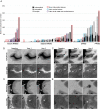This is a preprint.
Cortical lesions uniquely predict motor disability accrual and form rarely in the absence of new white matter lesions in multiple sclerosis
- PMID: 37886541
- PMCID: PMC10602044
- DOI: 10.1101/2023.09.22.23295974
Cortical lesions uniquely predict motor disability accrual and form rarely in the absence of new white matter lesions in multiple sclerosis
Abstract
Background and objectives: Cortical lesions (CL) are common in multiple sclerosis (MS) and associate with disability and progressive disease. We asked whether CL continue to form in people with stable white matter lesions (WML) and whether the association of CL with worsening disability relates to pre-existing or new CL.
Methods: A cohort of adults with MS were evaluated annually with 7 tesla (T) brain magnetic resonance imaging (MRI) and 3T brain and spine MRI for 2 years, and clinical assessments for 3 years. CL were identified on 7T images at each timepoint. WML and brain tissue segmentation were performed using 3T images at baseline and year 2.
Results: 59 adults with MS had ≥1 7T follow-up visit (mean follow-up time 2±0.5 years). 9 had "active" relapsing-remitting MS (RRMS), defined as new WML in the year prior to enrollment. Of the remaining 50, 33 had "stable" RRMS, 14 secondary progressive MS (SPMS), and 3 primary progressive MS. 16 total new CL formed in the active RRMS group (median 1, range 0-10), 7 in the stable RRMS group (median 0, range 0-5), and 4 in the progressive MS group (median 0, range 0-1) (p=0.006, stable RR vs PMS p=0.88). New CL were not associated with greater change in any individual disability measure or in a composite measure of disability worsening (worsening Expanded Disability Status Scale or 9-hole peg test or 25-foot timed walk). Baseline CL volume was higher in people with worsening disability (median 1010μl, range 13-9888 vs median 267μl, range 0-3539, p=0.001, adjusted for age and sex) and in individuals with RRMS who subsequently transitioned to SPMS (median 2183μl, range 270-9888 vs median 321μl, range 0-6392 in those who remained RRMS, p=0.01, adjusted for age and sex). Baseline WML volume was not associated with worsening disability or transition from RRMS to SPMS.
Discussion: CL formation is rare in people with stable WML, even in those with worsening disability. CL but not WML burden predicts future worsening of disability, suggesting that the relationship between CL and disability progression is related to long-term effects of lesions that form in the earlier stages of disease, rather than to ongoing lesion formation.
Figures


References
Publication types
LinkOut - more resources
Full Text Sources
